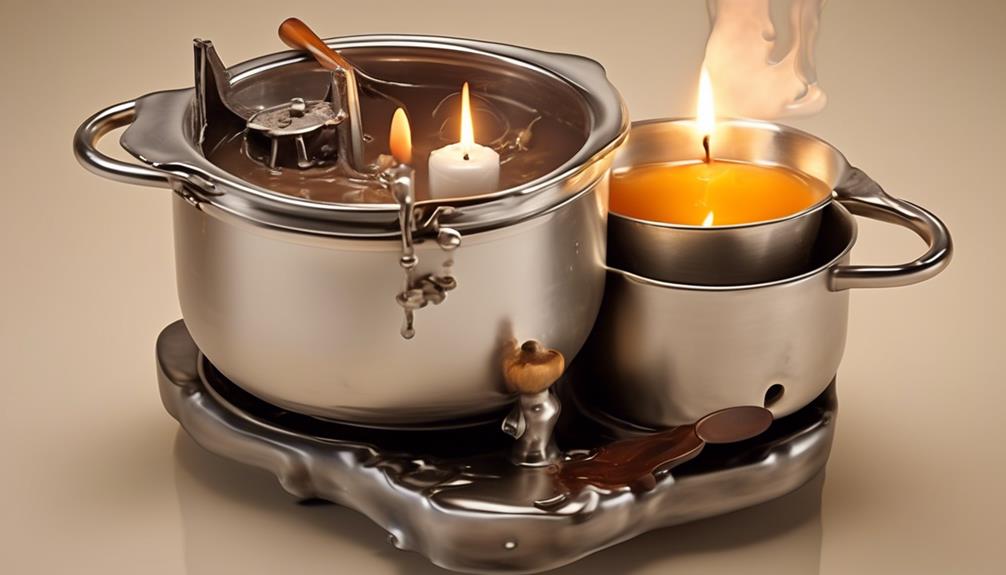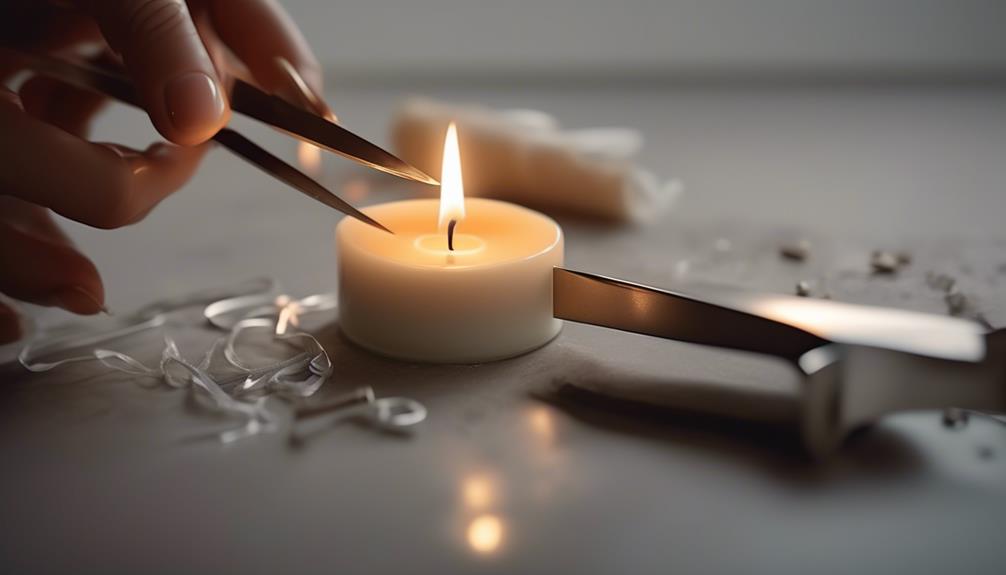Have you ever considered the technique of extinguishing a candle with only your fingertips? Mastering this skill requires comprehension, practice, and utmost caution.
In our quest for mastery, we delve into the intricacies of candle flames, understanding their behavior and the importance of safety. We prepare our hands, ensuring they are ready for the task at hand.
Through two techniques – the pinch method and the cover and smother method – we explore the art of extinguishing candles without any tools. However, it is crucial to know when attempting this method is not advisable.
We also explore alternative methods for those seeking a safer approach. Remember, practice makes perfect in this endeavor.
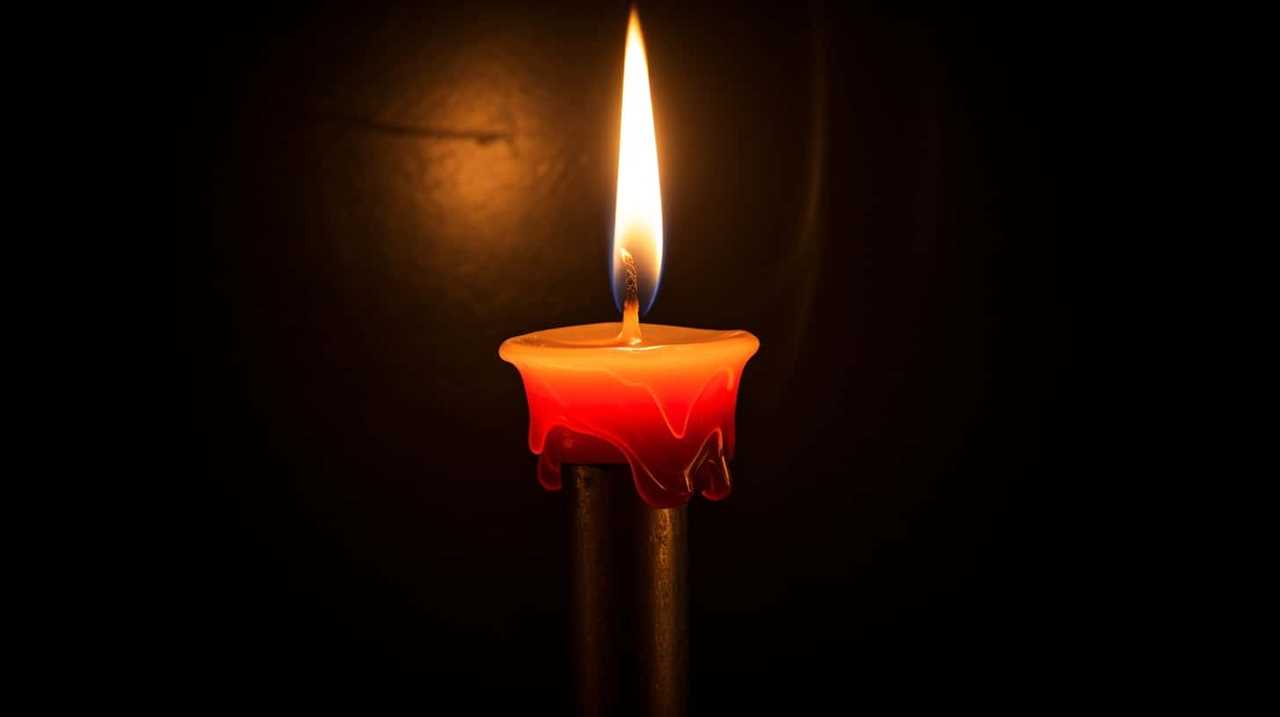
Join us on this journey as we uncover the secrets of putting out a candle with our fingers.
Key Takeaways
- Finger protection and fire prevention are crucial aspects to consider.
- The pinch method is a safe and effective technique for extinguishing a candle with your fingers.
- Safety precautions, such as keeping nails short and approaching the flame from the side, should be followed.
- Regular practice and finger exercises enhance hand flexibility, dexterity, and control over the flame.
The Importance of Safety
We emphasize the importance of safety when attempting to extinguish a candle with our fingers. Finger protection and fire prevention are crucial aspects to consider in order to avoid any potential harm.
Before attempting to put out a candle with our fingers, it’s essential to ensure that our hands are clean and dry to maintain a good grip. Additionally, trimming our nails short can help prevent any accidental scratches or burns.
It’s also advisable to have a nearby source of water or fire extinguisher, just in case the flames get out of control. Moreover, we must exercise caution and be aware of our surroundings to prevent any accidents.
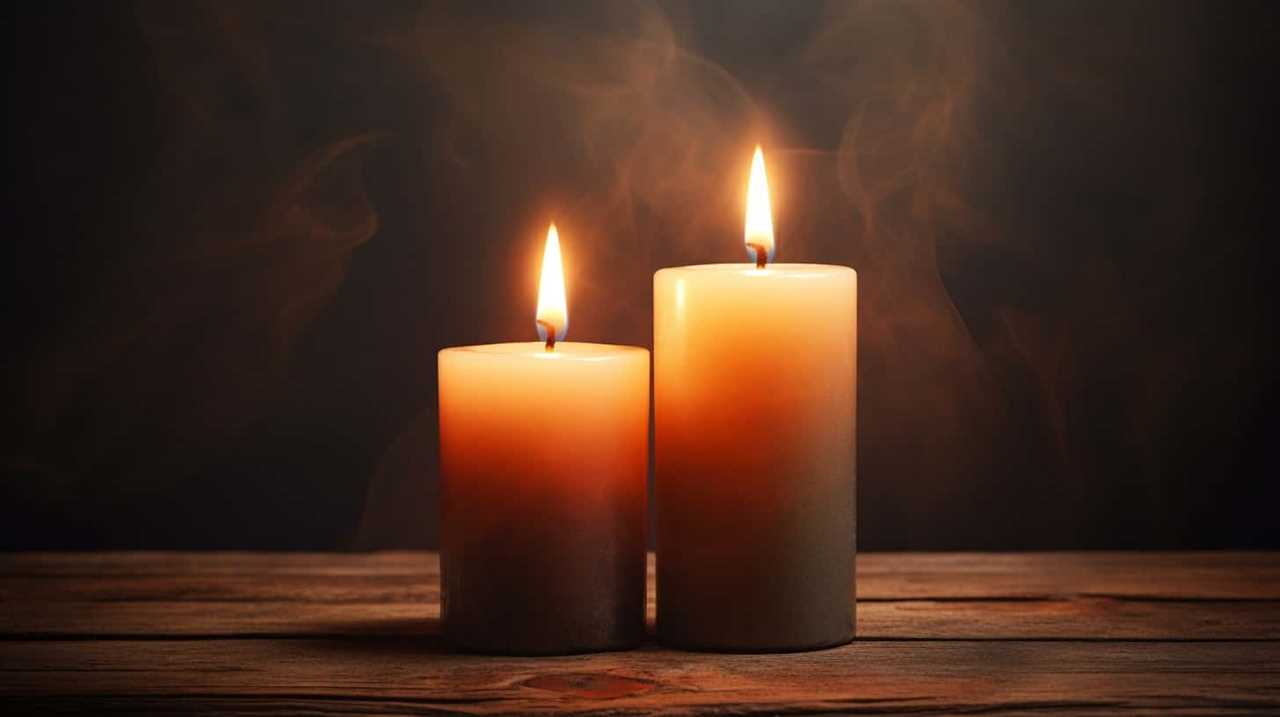
Understanding Candle Flames
To effectively extinguish a candle with our fingers, it’s essential to comprehend the behavior and characteristics of candle flames. Here are four important points to understand about candle flames:
- Candle flame colors: Candle flames can have different colors depending on the temperature and the elements present. A blue flame indicates a hotter temperature, while a yellow flame suggests a cooler temperature. Understanding the color can help gauge the intensity of the flame.
- Candle burning time: The duration a candle burns depends on various factors such as the size of the wick, the type of wax, and the ambient conditions. Thicker wicks and softer wax tend to burn longer. By considering these factors, one can estimate the remaining burning time of a candle.
- Flame shape and movement: Candle flames often have a teardrop shape, with a brighter, hotter base and a cooler, dimmer tip. The flame can flicker and dance due to air currents or uneven burning. Observing the flame’s movement can provide insights into the candle’s environment.
- Oxygen supply: A candle flame requires oxygen to sustain combustion. If the oxygen supply is limited or obstructed, the flame will weaken or be extinguished. Understanding this can help when attempting to put out a candle by using our fingers.
Preparing Your Hands
Understanding the behavior and characteristics of candle flames, we can now move on to preparing our hands for the task of extinguishing a candle with our fingers. To successfully accomplish this feat, it’s crucial to ensure that our fingers and hands are adequately prepared.
Finger exercises are an excellent way to enhance hand flexibility and dexterity, making it easier to manipulate and control the flame. Simple exercises like finger stretches, squeezing stress balls, or using hand grippers can significantly improve the flexibility and strength of our hands. Regular practice of these exercises won’t only increase our ability to safely extinguish a candle but also reduce the risk of injury.
Technique 1: The Pinch Method
Let’s now discuss the points related to the pinch method of extinguishing a candle with your fingers.
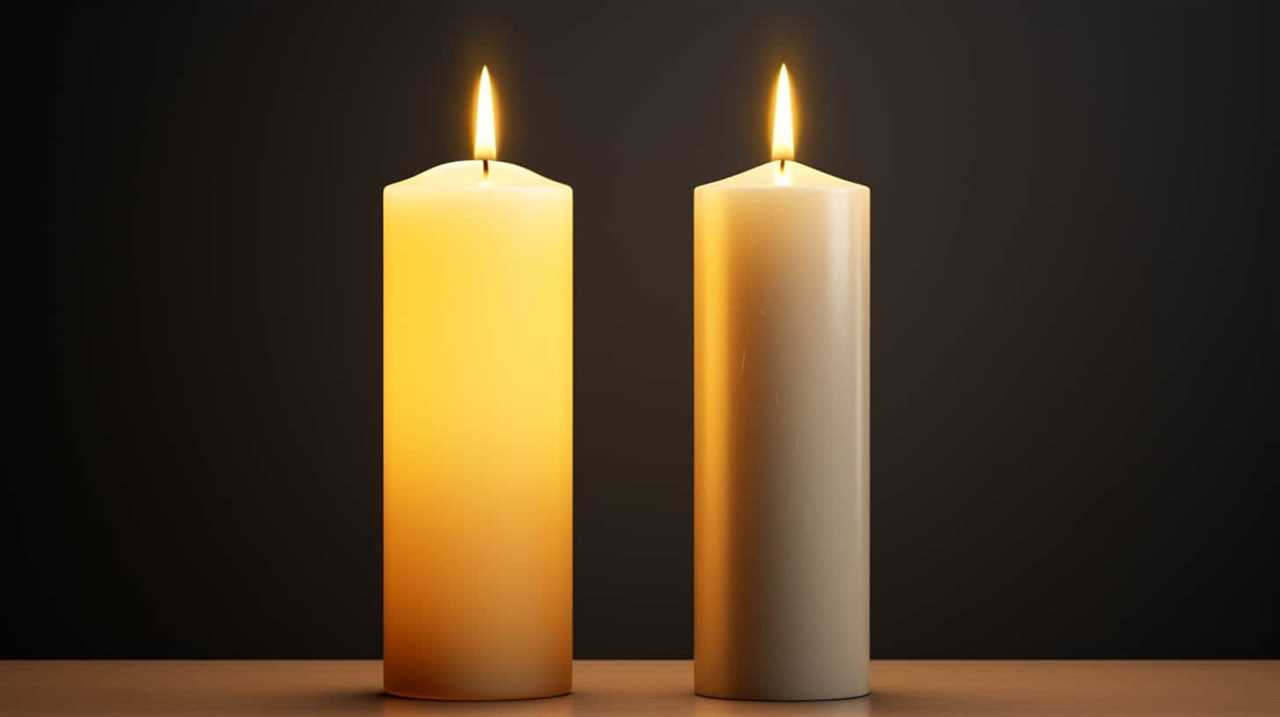
First, we need to consider finger safety precautions to protect ourselves from burns.
Additionally, it’s important to explore alternative methods for candle extinguishing in case the pinch technique doesn’t work effectively.
Finger Safety Precautions
When putting out a candle with our fingers, we need to be cautious and take safety precautions. Here are some finger safety tips to keep in mind:
- Finger exercises: Before attempting to pinch out a candle flame, it’s important to warm up your fingers and improve their dexterity. Perform simple stretches and hand exercises to loosen up your muscles and increase flexibility.
- Trim your nails: Long nails can increase the risk of injury when handling a lit candle. Keep your nails short to prevent accidental burns or scratches.
- Approach from the side: When extinguishing a candle using the pinch method, approach the flame from the side rather than from above. This minimizes the risk of getting too close to the flame and reduces the chances of burning your fingers.
- Know your limits: It’s essential to understand your own pain tolerance and refrain from attempting this technique if you have sensitive or easily injured fingers. Safety should always be a priority when dealing with open flames.
Candle Extinguishing Alternatives
To continue our discussion on candle extinguishing, let’s explore an alternative method known as the pinch technique.
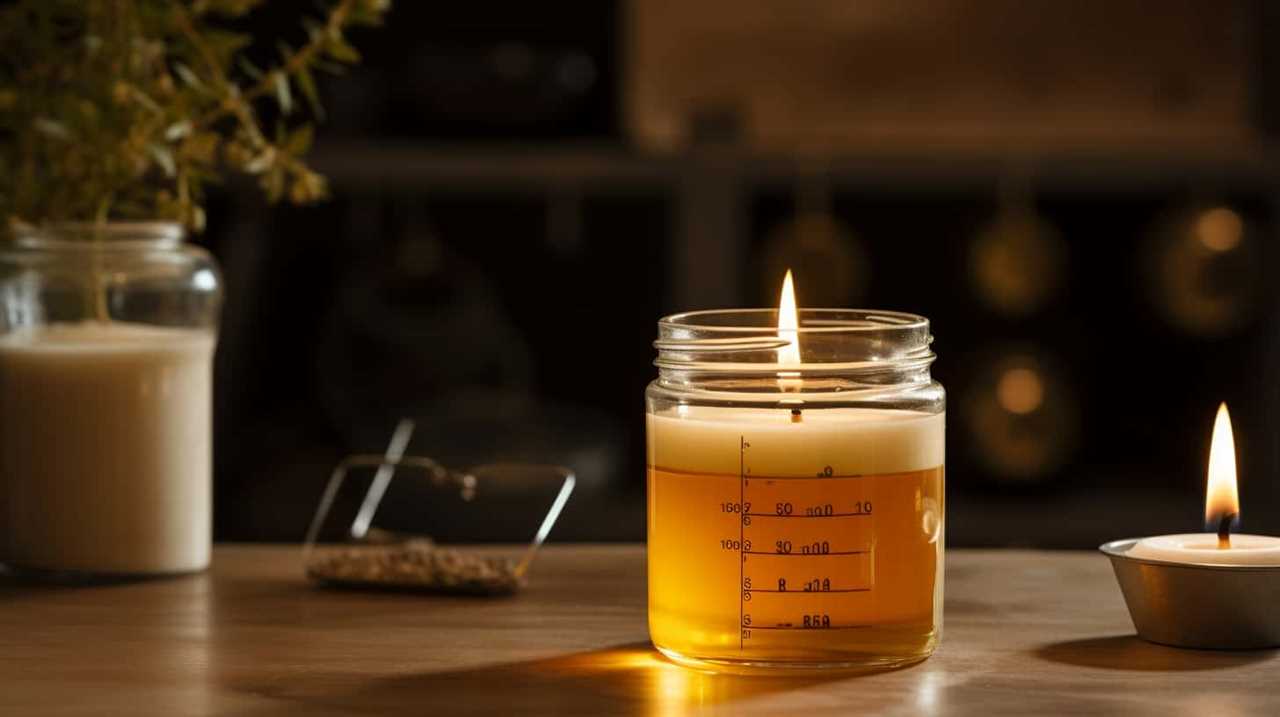
This technique involves using your thumb and index finger to pinch the wick of the candle, cutting off the oxygen supply and extinguishing the flame. The pinch method is a safe and effective way to put out a candle without the use of any tools or accessories.
However, it’s important to remember to practice proper finger safety and fire safety when using this technique. Make sure your fingers are dry and free from any oils or lotions that could increase the risk of burns. Additionally, be cautious of the hot wax and avoid touching it directly to prevent any injuries.
Pinch Technique Effectiveness
One effective method for extinguishing a candle with our fingers is by using the pinch technique. This technique requires proper finger technique and flame control to ensure safe and effective extinguishing. Here’s how to do it:
- Position your thumb and index finger: Place your thumb and index finger on opposite sides of the candle flame, ensuring a firm and controlled grip.
- Pinch the flame: Gently pinch the base of the flame, cutting off its oxygen supply. Be careful not to squeeze too hard or touch the hot wax.
- Hold for a few seconds: Maintain the pinch for a few seconds to allow the flame to die out completely.
- Release and check: Carefully release your fingers and observe the candle to ensure the flame is completely extinguished.
Technique 2: The Cover and Smother Method
We use a simple yet effective technique, known as the cover and smother method, to extinguish a candle with our fingers.
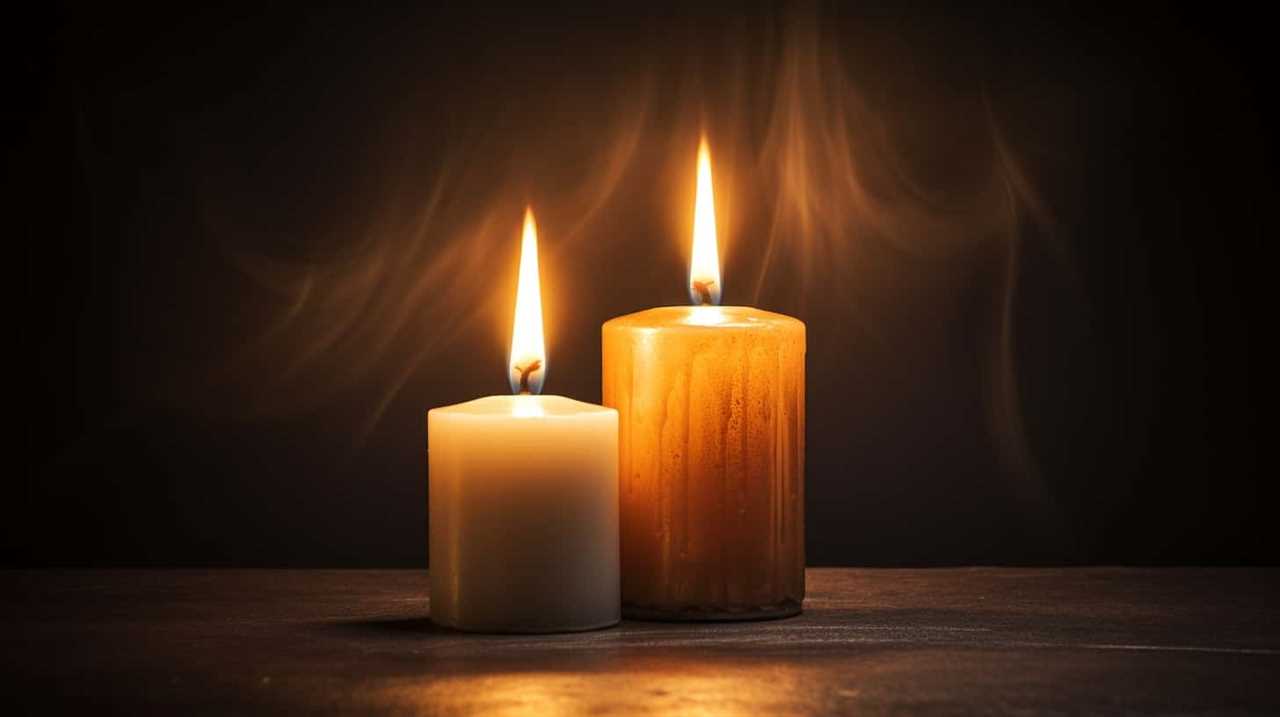
This technique involves placing our hand over the flame, completely covering it, and then smothering it by applying gentle pressure with our fingers.
The key to successfully using this method is to ensure that our fingers are adequately protected. We can achieve this by keeping our fingers together and slightly bent, forming a protective barrier. By doing so, we minimize the risk of getting burned.
While there are alternative techniques for extinguishing a candle with our fingers, the cover and smother method provides a reliable and efficient way to put out the flame.
With practice and proper finger protection, mastery of this technique is attainable.

Technique 3: The Blowout Method
Now let’s talk about Technique 3: The Blowout Method. This method involves blowing on the candle to extinguish the flame. It’s a popular and commonly used technique because it’s simple and requires no physical contact with the flame.
However, it’s important to note that blowing on a candle can sometimes cause hot wax to splatter, so it’s essential to take precautions.
Are there any alternative methods to blowing out a candle that are safer and equally effective? Let’s find out.
Safe Finger Extinguishing
After learning about the safe finger extinguishing techniques, we can now explore the third method known as the Blowout Method. This technique involves blowing out the candle with a forceful breath, using your fingers to shield the flame from your face.
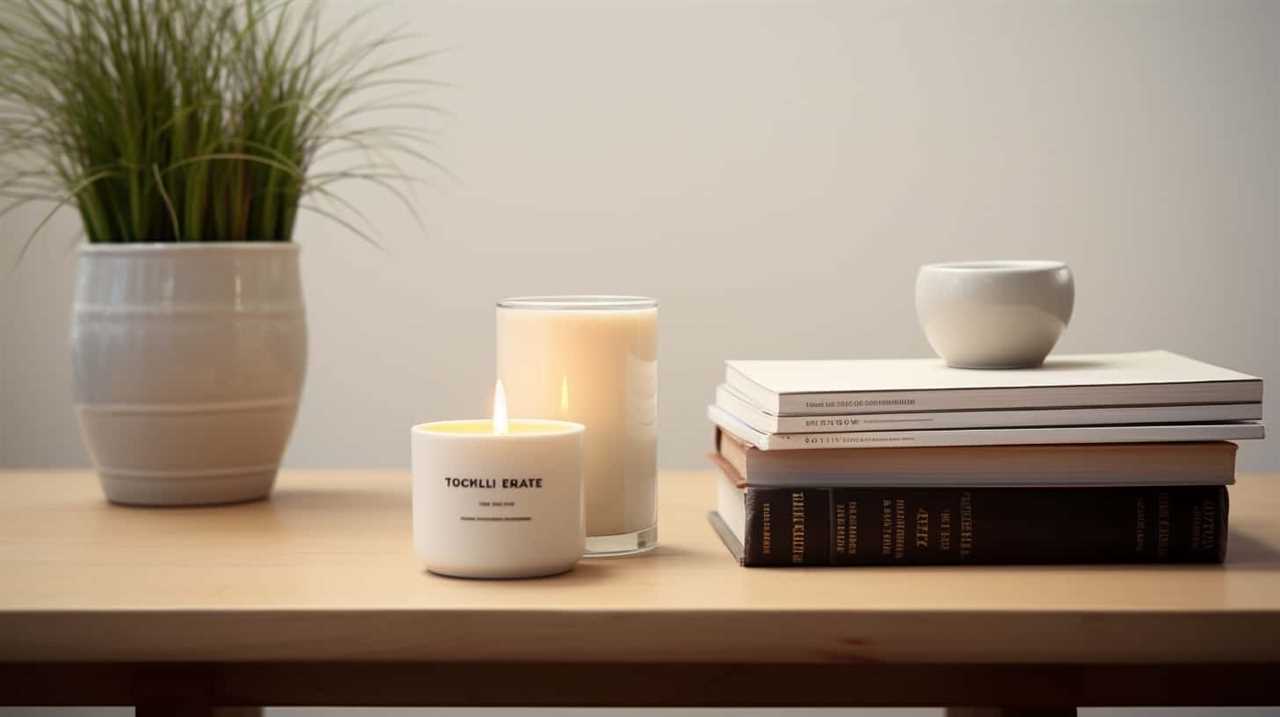
Here are the steps to safely execute the Blowout Method:
- Position your fingers: Hold your hand with your fingers slightly spread apart and positioned slightly above the flame.
- Take a deep breath: Inhale deeply to gather enough air for a forceful exhale.
- Aim for the base of the flame: Direct your breath towards the base of the flame, focusing on extinguishing it completely.
- Shield your face: Use your fingers to shield your face from any hot wax or sparks that may fly when blowing out the candle.
Alternatives to Blowing?
To explore alternatives to blowing out a candle with your fingers, let’s delve into the effectiveness of the Blowout Method. This technique involves blowing on the candle to extinguish the flame instead of using your fingers. While it may seem simple, there are important considerations to ensure finger protection and candle safety.
When using the Blowout Method, make sure to position your face at a safe distance from the flame to avoid burns. Additionally, be cautious of any loose clothing or hair that could catch fire. It’s also crucial to blow gently and steadily to prevent hot wax from splattering.
Technique 4: The Wet Fingers Method
One effective way to extinguish a candle using our fingers is by using the wet fingers method. This technique involves wetting our fingers before attempting to put out the flame. Here’s how to do it safely and effectively:

- Prioritize finger safety: Make sure your fingers are clean and free from any cuts or open wounds. Wetting your fingers can make them more susceptible to burns, so it’s important to exercise caution.
- Wet your fingers: Dip your fingertips into a bowl of water, ensuring that they’re thoroughly wet. This will provide a protective barrier between your skin and the flame.
- Pinch the wick gently: Using your wet fingers, pinch the base of the wick where it meets the wax. Apply gentle pressure to smother the flame.
- Hold for a few seconds: Hold your fingers on the wick for a few seconds to ensure the flame is completely extinguished.
Remember to always prioritize fire safety and exercise caution when attempting to put out a candle with your fingers.
Technique 5: The Wax Barrier Method
Now, let’s delve into Technique 5: The Wax Barrier Method, where we create a protective shield using melted wax.
This technique involves carefully melting the wax from the candle and creating a small pool of liquid wax in your palm. Once the wax is melted, you quickly dip your fingertips into the liquid wax, coating them with a thin layer. The wax barrier acts as a protective layer between your fingers and the flame, effectively preventing any burns. It’s important to ensure that the layer of wax is thin and even to maximize its effectiveness.
With practice and patience, mastering the technique of creating a wax barrier can provide a safe and efficient way to extinguish a candle using your fingers.

Now, let’s move on to Technique 6: The Candle Snuff Method.
Technique 6: The Candle Snuff Method
For Technique 6, we’ll explore the Candle Snuff Method, which builds upon the protective wax barrier discussed in the previous subtopic. When using this technique, it’s important to prioritize finger protection to ensure safety.
Here are four snuffing techniques to help you put out a candle with your fingers:
- The Pinch and Snuff: Gently pinch the wick between your thumb and index finger, then swiftly snuff it out by pressing your fingers together.
- The Snap and Snuff: Hold the wick between your thumb and middle finger, and snap your fingers downward to break the flame. Immediately follow with a snuffing motion to extinguish it completely.
- The Roll and Snuff: Roll the tip of your thumb and index finger over the wick, applying slight pressure as you move from one side to the other. Finish by snuffing the flame.
- The Slide and Snuff: Place your thumb and index finger on opposite sides of the wick. Slowly slide your fingers together, compressing the wick until the flame is extinguished.
Mastering these snuffing techniques will enhance your ability to safely extinguish candles with your fingers. Remember to exercise caution and always prioritize finger protection.

Common Mistakes to Avoid
To avoid common mistakes, we should ensure that we have a firm grip on the candle and maintain steady pressure while extinguishing the flame with our fingers.
One common mistake to avoid is not positioning our hand correctly. It is crucial to place our fingers on the sides of the flame, rather than directly on top, to prevent finger injuries. Placing our fingers on top of the flame increases the risk of getting burned.
Another mistake to avoid is not applying enough pressure when pinching the flame. If we do not exert enough pressure, the flame may not be fully extinguished, resulting in a potential fire hazard.
Fire Safety Tips
When it comes to fire safety, it’s essential for us to be aware of and follow proper precautions. Here are some important tips to prevent fire accidents and ensure candle care:

- Keep flammable materials away from candles: Make sure to keep curtains, papers, and other flammable objects at a safe distance from burning candles.
- Never leave candles unattended: Always remember to extinguish candles before leaving a room or going to bed.
- Use stable candle holders: Place candles in sturdy holders that won’t easily tip over, causing a potential fire hazard.
- Keep candles out of reach of children and pets: Children and pets can accidentally knock over candles or be burned by the flame, so it’s important to keep them out of their reach.
Following these fire safety tips can greatly reduce the risk of accidents.
However, there are situations when attempting to put out a candle with your fingers isn’t recommended.
When Not to Attempt This Method
Before attempting to put out a candle with your fingers, it’s important to be aware of safety precautions for beginners. This method requires a certain level of skill and experience, so it isn’t recommended for those who are inexperienced or unsure.
Additionally, there are alternative extinguishing techniques that can be used instead, such as using a candle snuffer or blowing it out gently.
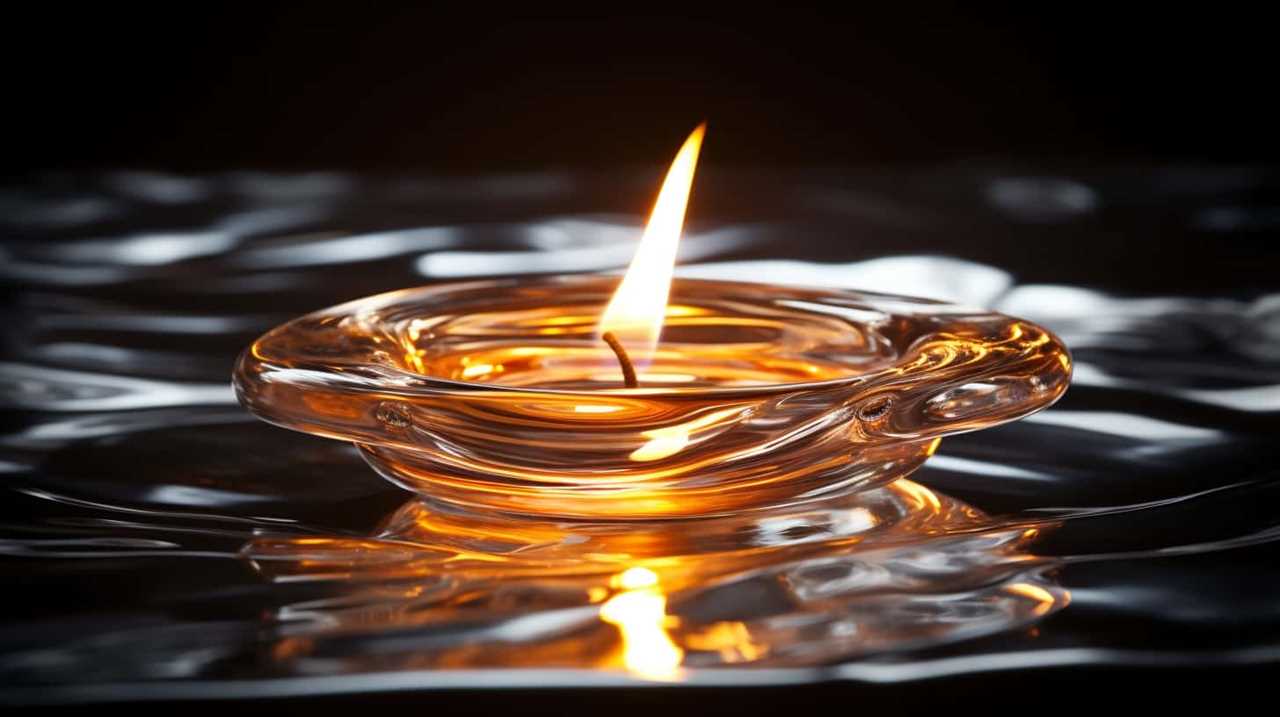
Safety Precautions for Beginners
We should exercise caution and refrain from attempting this method if we’re inexperienced or unsure of our ability to safely extinguish a candle with our fingers. Safety should always be our top priority, especially when dealing with open flames. Here are some precautions for beginners to keep in mind:
- Assess your comfort level: Before attempting to put out a candle with your fingers, make sure you’re confident and comfortable with the technique. It’s okay to start with other beginner-friendly techniques first.
- Consider the size of the flame: If the flame is too large or flickering uncontrollably, it’s best to use a proper extinguishing tool like a snuffer or a candle extinguisher. Avoid attempting to use your fingers in such situations.
- Avoid long nails or jewelry: Long nails or jewelry can increase the risk of injury when attempting to put out a candle with your fingers. Keep your nails short and remove any jewelry that may interfere with the process.
- Stay focused and mindful: Always be fully present and attentive when attempting this method. Distractions or lack of focus can lead to accidents and burns.
Alternative Extinguishing Techniques
If we’re inexperienced or unsure of our ability to safely extinguish a candle with our fingers, it’s important to explore alternative techniques for putting out the flame.
While the method of using our fingers can be effective, it requires a certain level of skill and finger protection. If we don’t feel confident in our ability to do this safely, it’s best to consider other options.
One alternative technique is to use a candle snuffer, which is a small cone-shaped tool designed specifically for extinguishing candles.

Another technique is to blow out the flame using breath control. By gently blowing on the flame from a safe distance, we can effectively extinguish the candle without putting ourselves at risk.
It’s crucial to prioritize our safety and choose the method that best suits our skill level and comfort.
Alternative Methods for Extinguishing Candles
One can explore various alternative methods to extinguish candles without using their fingers. Here are four creative extinguishing methods that provide finger protection:
- Candle snuffer: This tool is specifically designed to safely extinguish candles. Gently place the snuffer over the flame, allowing it to suffocate and extinguish the candle without any risk to your fingers.
- Candle dippers: These long, slender tools allow you to dip the wick into the melted wax, cutting off the oxygen supply and extinguishing the flame. Be sure to let the wax solidify before removing the dipper.
- Candle extinguishing spray: This innovative product releases a fine mist that quickly puts out the candle flame. Simply aim the spray at the flame from a safe distance and press the nozzle.
- Candle lid: If your candle came with a lid, you can use it to extinguish the flame. Place the lid over the candle, cutting off the oxygen supply and smothering the flame.
Practice Makes Perfect
Now that we’ve learned about alternative methods for extinguishing candles, let’s discuss the importance of practice in mastering the technique of putting out a candle with our fingers.
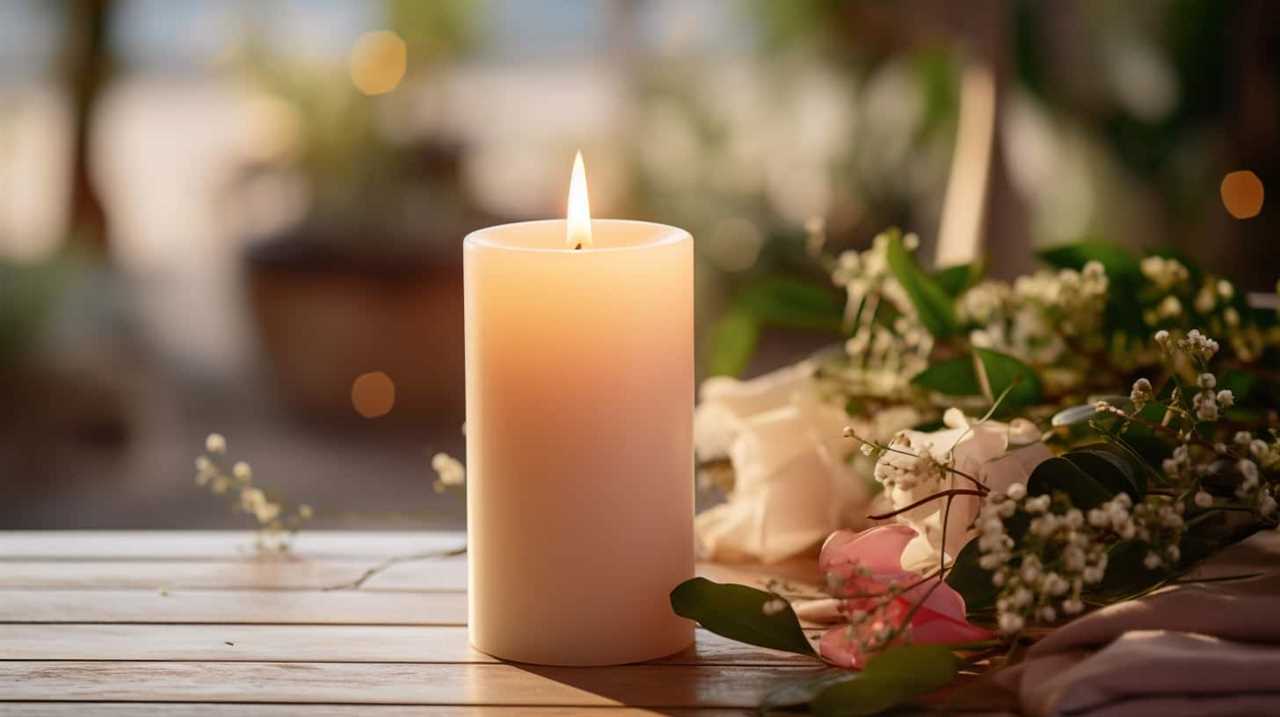
Developing this skill requires consistent practice, as it involves building muscle memory and refining our technique. By dedicating time to practice, we can improve our precision and control, allowing us to confidently extinguish candles with our fingers.
Skill Development Tips
We frequently practice our skills to achieve perfection. When it comes to developing finger dexterity and hand-eye coordination, consistent practice is key. Here are some tips to help you improve these essential skills:
- Finger exercises: Engage in activities that promote finger dexterity, such as playing a musical instrument or using hand grip strengtheners. These exercises will help improve the strength and flexibility of your fingers.
- Hand-eye coordination games: Play video games or engage in activities like juggling or throwing and catching a ball. These activities require precise coordination between your hands and eyes, helping to enhance your overall coordination skills.
- Fine motor skill practice: Engage in activities that require precise finger movements, such as painting, drawing, or assembling small objects. These activities will help develop your fine motor skills and improve your control and accuracy.
- Practice with tools: Use tools that require intricate finger movements, such as knitting needles or a Rubik’s Cube. Regular practice with these tools will enhance your finger dexterity and coordination.
Benefits of Consistent Practice
Developing finger dexterity and hand-eye coordination through consistent practice offers numerous benefits to individuals striving for mastery in their chosen skill. The benefits of consistency cannot be overstated, as it plays a crucial role in achieving excellence. By persevering and practicing regularly, individuals can reap the following rewards:
| Benefits of Consistency | The Role of Perseverance | Improved skill mastery | Increased efficiency | Enhanced muscle memory |
|---|---|---|---|---|
| Consistent practice allows for continuous improvement and mastery of the skill. | Perseverance is essential in overcoming challenges and setbacks along the way. | Regular practice helps to refine techniques and achieve a higher level of proficiency. | Consistency leads to improved efficiency and speed in performing the skill. | Through consistent practice, muscle memory is developed, enabling smoother and more precise movements. |
Final Thoughts and Conclusion
After considering various methods and techniques, we’ve reached the conclusion that extinguishing a candle with your fingers is indeed a delicate and precise skill. Through consistent practice, one can develop the necessary control and dexterity to perform this technique effectively.
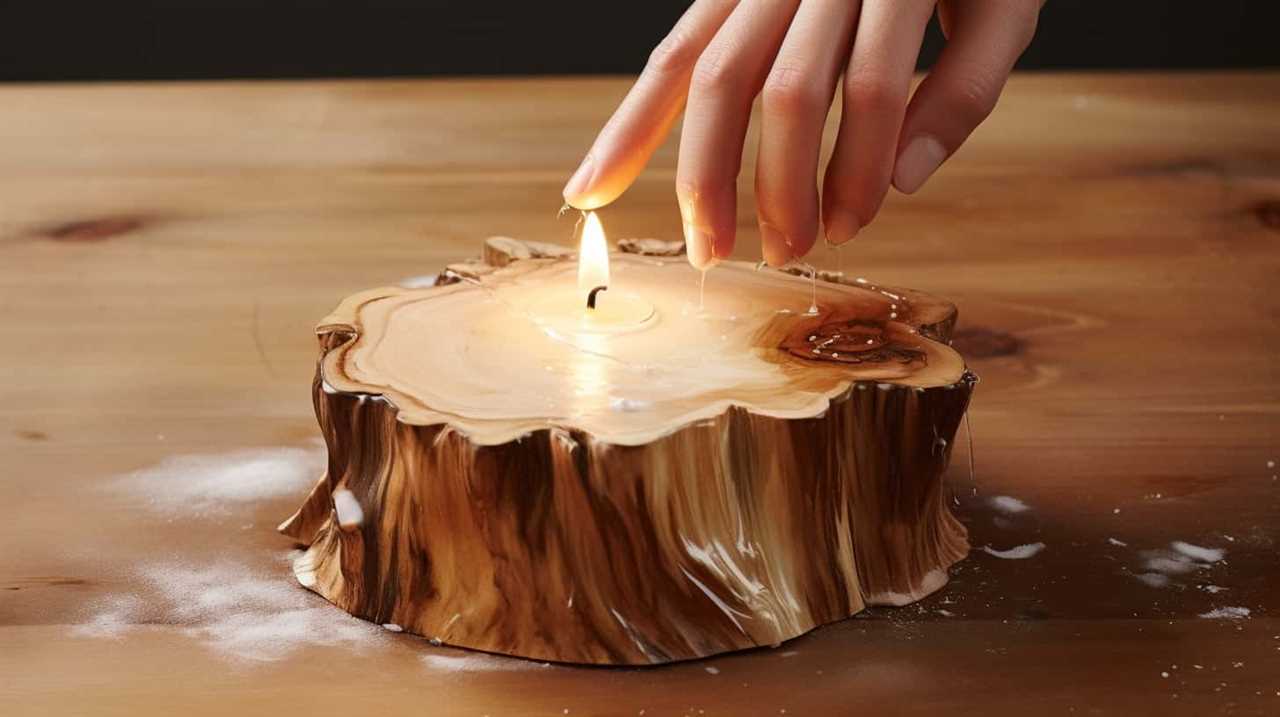
Here are some final thoughts and conclusions to keep in mind:
- Alternative extinguishing techniques: While using fingers is a unique skill, it’s important to remember that there are other methods available, such as using a snuffer or blowing out the candle.
- Benefits of consistent practice: By regularly practicing this technique, you can improve your hand-eye coordination and increase your ability to control the pressure and speed of your fingers.
- Patience and focus: Extinguishing a candle with your fingers requires a calm and focused mindset. It’s crucial to remain patient and avoid rushing the process.
- Safety precautions: Always exercise caution when attempting this skill. Ensure that your fingers are clean and dry, and be aware of any potential hazards, such as hot wax or a too-hot flame.
Frequently Asked Questions
Can I Use Any Type of Candle for These Techniques?
When it comes to putting out a candle with our fingers, it’s important to consider the different types of candles we may encounter. We must also prioritize safety precautions while attempting these techniques.
Is There a Specific Age Limit for Attempting These Techniques?
Age limitations and safety precautions should always be considered when attempting techniques involving fire. It’s important to ensure that individuals attempting these methods are of an appropriate age and have the necessary knowledge to do so safely.
Are There Any Specific Hand Positions or Grips I Should Use?
When attempting to extinguish a candle with our fingers, it is crucial to maintain proper hand positions and utilize effective finger grips. Mastering these techniques will ensure a safe and successful outcome.

Can I Use Gloves or Any Other Protective Gear While Attempting These Techniques?
Gloves or other protective gear might be considered for safety precautions when attempting techniques involving extinguishing candles with fingers. However, alternatives like proper hand positioning and controlled movements can also ensure safety.
What Should I Do if My Fingers Get Burned While Attempting These Techniques?
If our fingers get burned while attempting these techniques, we should immediately stop and treat the burn. First aid for burns includes running cold water over the affected area and seeking medical attention if necessary.
Conclusion
In conclusion, extinguishing a candle with your fingers can be done safely and effectively using the pinch or cover and smother methods. It’s important to prioritize safety and understand the behavior of candle flames before attempting these techniques.
However, if you aren’t comfortable with using your fingers, there are alternative methods available.

Remember, practice makes perfect when it comes to mastering this skill. So, why not test your newfound knowledge and see if you can put out a candle with your fingers?









